|
C u b a n S p e c i a l

The R-1 from Baldwin, the most beautiful engine of the Florida Special (Baldwin)
To Florida
The American way to the Caribbean was the way by the Pennsy, the Atlantic Coast Line and the “Florida Special” to Miami, since 1896 connected by Henry M. Flagler’s Florida East Coast Railway. “Then, to tap the Cuban trade and also because Key West was the closest port to the Panama Canal (then under construction), he decided to build a line south for Key West” (G.H. Drury: The Train-Watcher’s Guide to North American Railroads). From 1912 the Florida Special had sleeping-cars to Key West, combined with the Over-Sea Limited. In 1935 a hurricane destroyed the railroad dam for ever. The special remained the fashionable train for Miami, during season running in three sections. Pacifics had replaced Atlantics and in 1938 came the R-1 Niagaras from Baldwin, beautiful but too heavy.
Rivaling Seaboard Air Line introduced in 1939 the stainless Silver Meteor streamliner New York-Miami, diesel-hauled, but its St. Petersburg branch was headed by streamlined old Pacifics, painted orange/cream/green.
The Florida Special was suspended during WWII and only in 1949 the New Florida Special appeared as a sparkling stainless streamliner, hauled by three dark purple-red bulldog-nosed GM/EMD E types. Under Amtrak, the Silver Meteor on the route via Charleston and the Silver Star via Columbia continued to connect New York with Miami, both later equipped with Viewliner sleepers in addition to the Amfleet cars. North of Washington they are electrically-hauled by AEM7 engines. South of the capital initially heritage engines, then F40PH and later P42DC diesels came into use. The other great express to Florida became the Auto Train from Lorton (near Washington D.C.) to Sandford, started in December 1971. Three U36B diesels hauled 30 cars, including refurbished sleepers and dome cars ex ATSF, UP and WP, painted white/red/purple. Between 1974 and 79 there was also a train from Louisville, Kentucky, and even services in the West and in Mexico were considered. In 1981 however the Auto Train Corp. went bankrupt and in October 1983 Amtrak continued the service, later with Superliner cars.
Chronology
1888: New York & Florida Special, all-sleeper Pullman de-Luxe, initially Jersey City - Washington - Richmond - Charleston - Jacksonville via Pennsy, the Richmond, Fredericksburg & Potomac Rr., Atlantic Coast Line, 1896 to Miami via Florida East Coast Railway, 1912 New York - Key West, at Miami combined with Over-Sea Limited; then Florida Special.
1903: Havana - Santiago completed
1916: Hershey Cuban Railway, a secondary line, later electrified
1935: Miami - Key West destroyed by hurricane
1939: Champion streamliner New York - Miami by Atlantic Coast Line
1939: Silver Meteor streamliner New York - Miami/St. Petersburg by Seaboard Air Line.
1940: Dixie Flagler and South Wind, steam-hauled streamliners Chicago - Miami.
1949: New Florida Special streamliner New York - Miami by Atlantic Coast Line.
1971: Amtrak took over and finally only the Silver Star New York - Columbia - Tampa - Miami, the Silver Meteor New York - Charleston - Tampa - Miami and the Auto Train Lorton (near Washington D.C.) - Sanford, Florida, (started in 1971) survived.
For the history of connecting shipping lines see www.ships-worldwide.com..
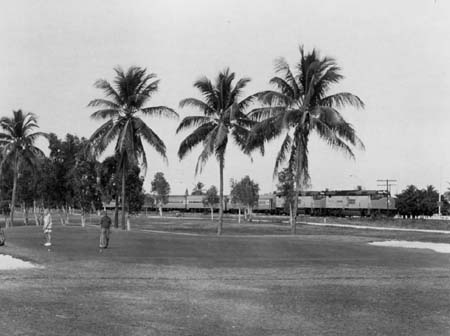
An E9 of Amtrak in Florida, probably with the Silver Star during the 70s (Amtrak)
|
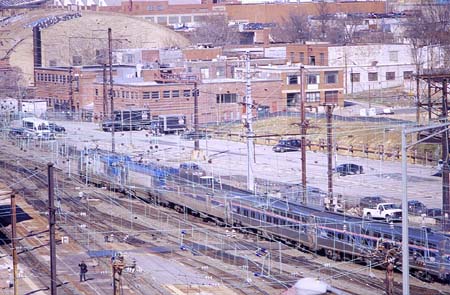
Silver Star Miami – New York with Viewliner sleepers, departing on the electrified line from Washington Union Station, 2008 (WS)
|
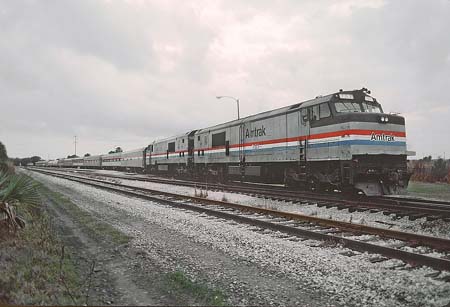
Auto Train, Amtrak 707 class at Sanford, Florida 1987 (Roger Puta, via Wikimedia)
|
|
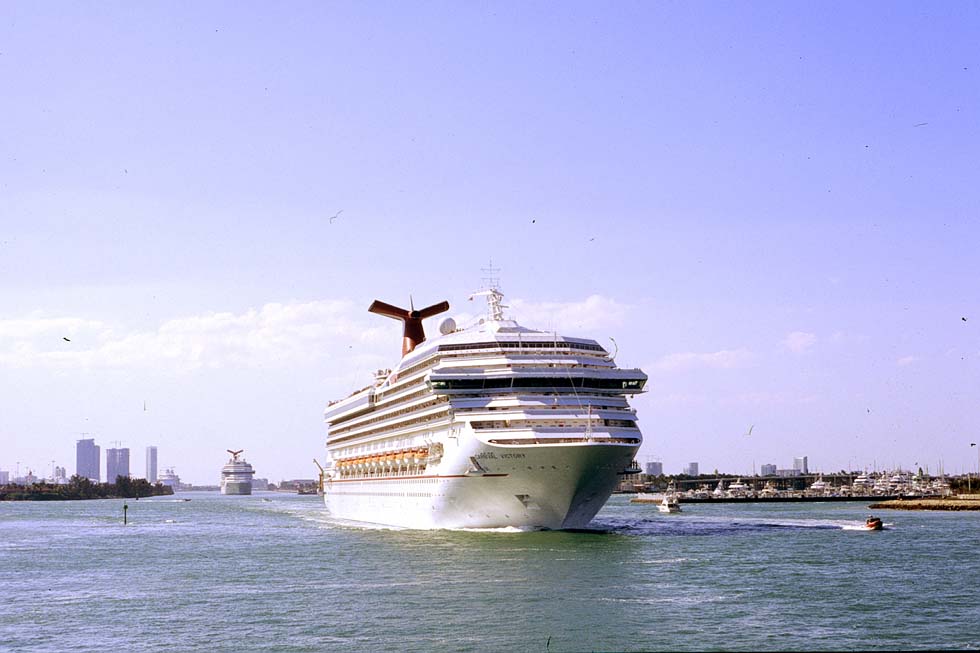
Miami, departure of the cruise ships „Carnival Victory“ and „Carnival Valor“, 2007 (WS)
Download this picture with 1500 x 1000 pix, 300 dpi

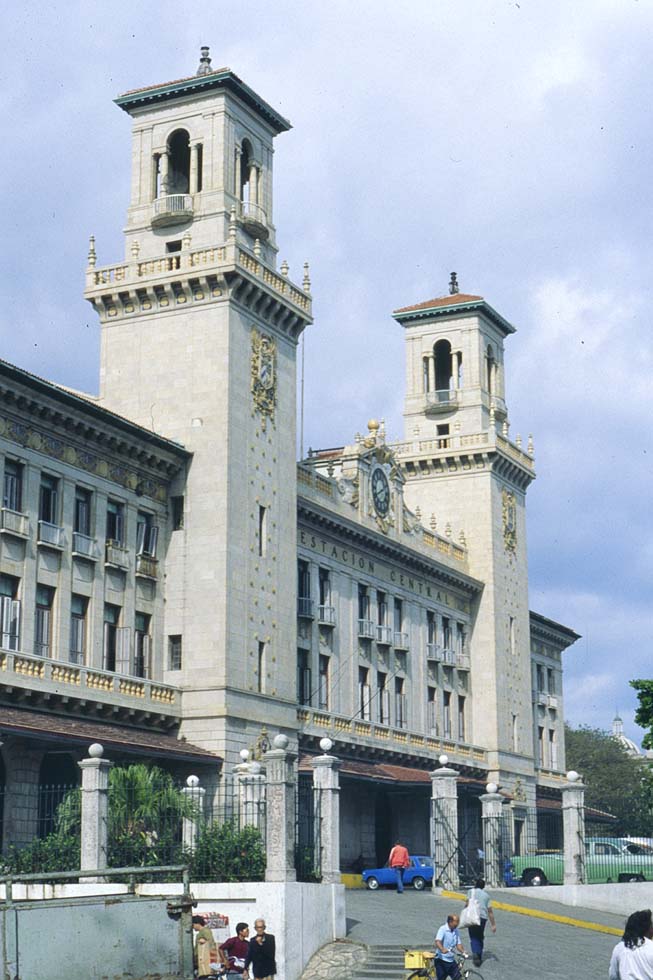
Havana Central station, 1999 (WS)
Cuba and Caribbean
“The gates of Cuba have been opened by the Pullman Company to those discriminating travelers who wish to explore the Island Republic and enjoy its lovely climate with the minimum of effort and the maximum of comfort”, informed a brochure in 1924 (quoted by Arthur D. Dubin). It was the gorgeous Cuban Special which every Monday between January and April 1925 at Havana docks awaited the arrival of the Peninsular & Occidental steamer “Cuba” from Key West. Consisting of redecorated wooden Pullman cars, it took the tourists on a round trip to Camaguey, Santiago, Matanzas and back to Havana, where they could live aboard the train until the steamer’s departure on Monday. A few years later they could have gambled in the new Hotel National where dictator Battista earned five million dollar annually from the mafia...
The first railway at Havana started already in 1837. Towards 1860 it reached Santa Clara and in 1903 Santiago. On the main lines, American 4-4-0 engines hauled American - style cars. In 1958 Che Guevara’s men blew up a military train near Santa Clara and Fidel Castro took over. Nationalized FCC upgraded the line to Santiago, Russia sent TE114K and M26K diesels, but Express 1 Havana - Santiago was seen in the ‘80s with a red/cream Canadian MX and olive-green or red/cream coaches of the Argentinian Fiat type. The less prominent train 8 Santiago - Havana was photographed around 1992 with a TE114K and green second-hand Spanish cars. From 1986 Argentinian type cars were built in Cuba and those ones used for Express 1 got a striking light-turquoise/cream paint scheme. Then even stainless ex-TEE cars were sent from France and in 2005 Cuba got the first locomotives from China, type DF7G-C diesels.
The other standard-gauge island railway had started in 1845 in Kingston, Jamaica. In 1895 the link with Montego Bay and in 1896 with Port Antonio was completed. After WWII new American 4-8-0 USA/TC type locomotives hauled trains with old wooden bogie coaches. Still in the '80s British railcars and the ancient Governor's coach carried happy tourists through the tropics. In 1992 however passenger traffic was closed down.
On the Bermudas, in Puerto Rico, Haiti, the Dominican Republic, Guadeloupe, Martinique, Barbados and Trinidad long ago railways had disappeared, but 2ft 6in gauge steam trains for tourists on St. Kitts island appeared in the timetable and other projects were started.
Cuban Special
Havana Docks - Santiago - Matanzas - Havana Docks, by Pullman Co., standard gauge, 1925
| A… | kitchen car | Ex "Honorious" |
| B | dining room | ex "Port Chester", N+H Merchants Ltd. |
| C | compartment sleeper, parlor | ex "Louisiana" from exhibition |
| D | compartment sleeper, parlor | ex "Kaaterskill", 20th Century Ltd. |
| E | compartment sleeper, parlor | ex "Knickerbocker", 20th Century Ltd. |
| F | section sleeper, parlor | ex "Ben MacDhui", Golden State |
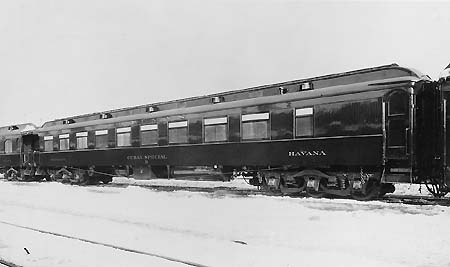 Cuban Special diner; a former observation-parlor car of the Merchants Limited New York - New Haven - Boston, in 1925 (Pullman Co./ coll. Arthur D. Dubin)
Cuban Special diner; a former observation-parlor car of the Merchants Limited New York - New Haven - Boston, in 1925 (Pullman Co./ coll. Arthur D. Dubin)
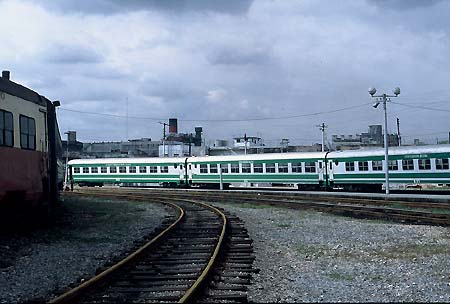 Express 1 Havana - Santiago, Havana Central, Feb. 1999 (WS)
Express 1 Havana - Santiago, Havana Central, Feb. 1999 (WS)
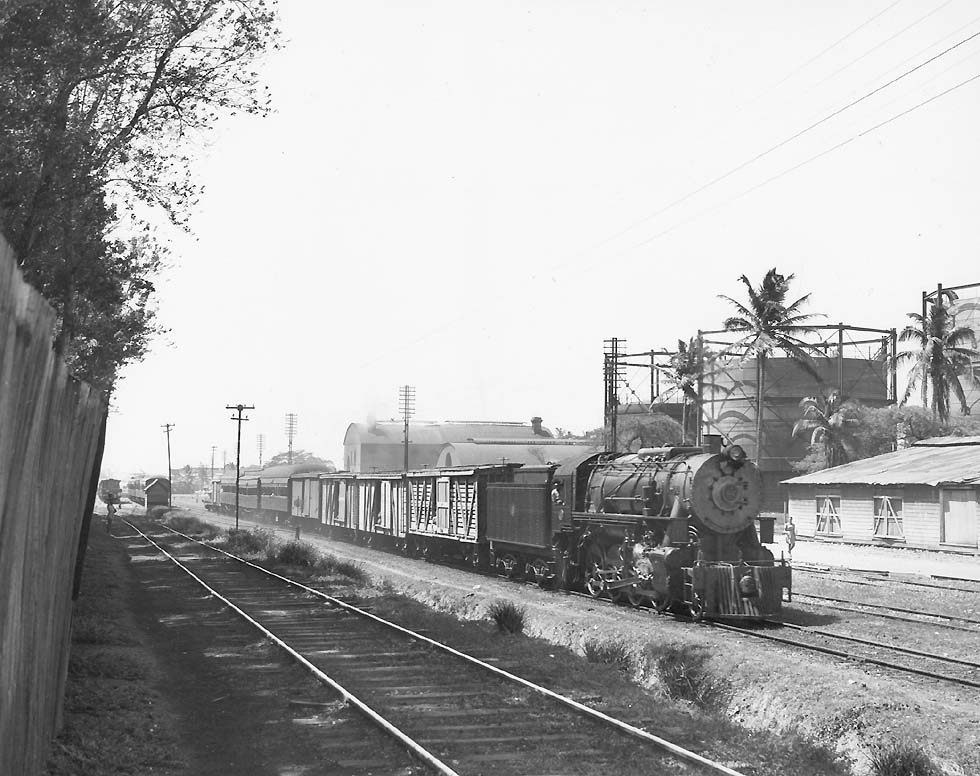
Engine no.62 of Jamaica Government Railway, built by Alco-Schenectady in 1945, departure at Kingston in June 1947 (Charles S. Small)
|


 Cuban Special diner; a former observation-parlor car of the Merchants Limited New York - New Haven - Boston, in 1925 (Pullman Co./ coll. Arthur D. Dubin)
Cuban Special diner; a former observation-parlor car of the Merchants Limited New York - New Haven - Boston, in 1925 (Pullman Co./ coll. Arthur D. Dubin)
 Express 1 Havana - Santiago, Havana Central, Feb. 1999 (WS)
Express 1 Havana - Santiago, Havana Central, Feb. 1999 (WS)









